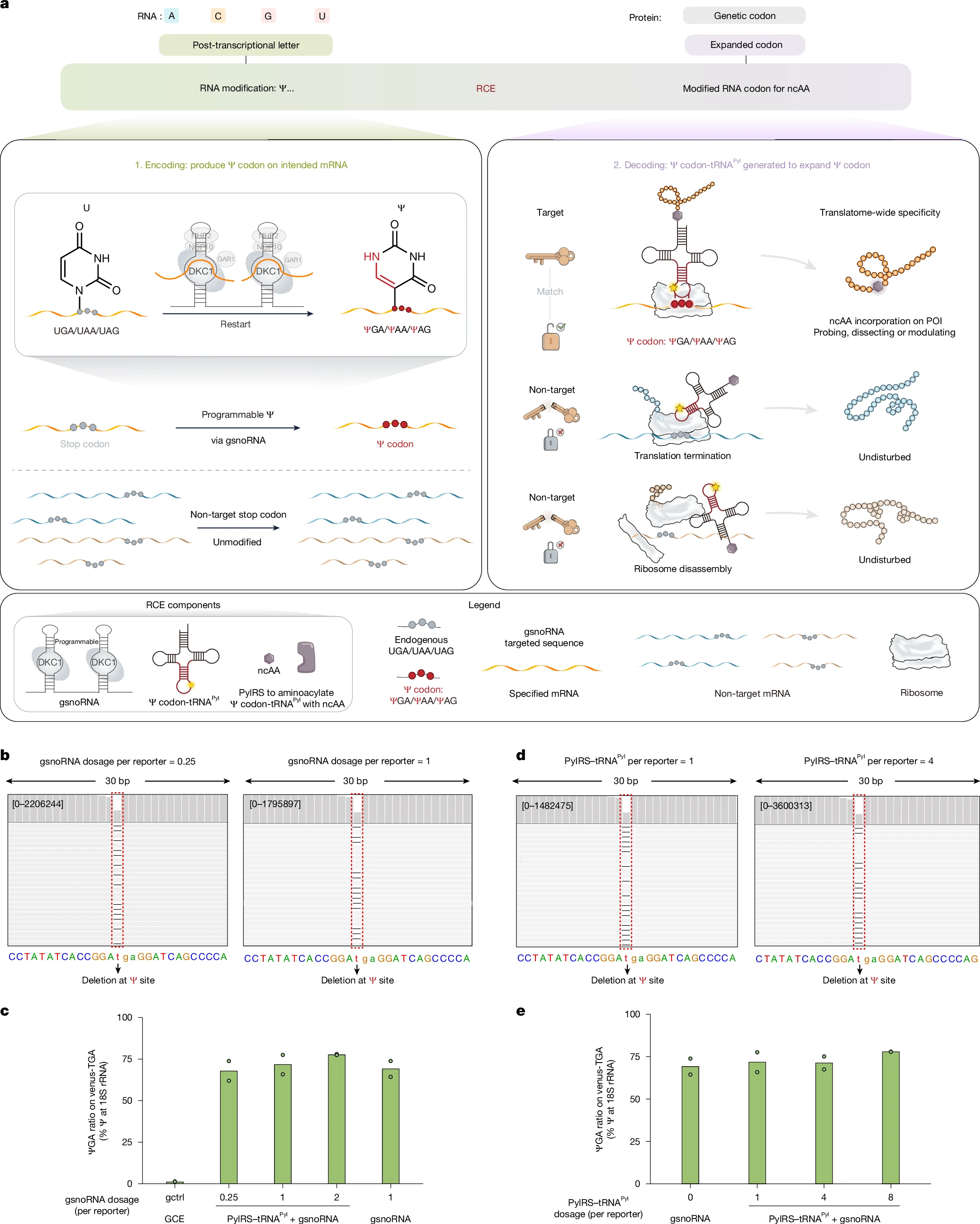Peking University, June 27, 2025: To overcome the inherent challenge of translation termination interference caused by stop codon reprogramming in mammalian cells, researchers from Peking University led by Chen Peng from College of Chemistry and Molecular Engineering and Yi Chengqi from School of Life Sciences have developed a novel codon expansion strategy that enables precise incorporation of noncanonical amino acids (ncAAs) without perturbing natural genetic codes. This innovative approach utilizes post-transcriptionally modified RNA codons—distinct from all 64 standard genetic codons—within targeted transcripts to encode ncAAs in mammalian systems. This work establishes a versatile platform for expanding the genetic code in mammalian cells, paving the way for advanced protein engineering and functional studies in complex biological systems. These findings were published in
Nature on June 25, 2025, under the title "RNA codon expansion via programmable pseudouridine editing and decoding."
Why it matters:
The site-specific incorporation of non-canonical amino acids (ncAAs) provides new opportunities to tailor protein functions with custom chemistries. Traditional genetic code expansion (GCE) strategies achieve ncAA incorporation by reassigning stop codons as “blank” codons, which is not fully orthogonal to endogenous translation termination, limiting its precision and scope in cellular contexts. This RCE method utilizes bio-orthogonally assigned pseudouridine-modified codons (ΨCodons: ΨGA, ΨAA, or ΨAG) at designated mRNA transcripts for ncAA incorporation in mammalian cells. The RCE platform integrates a programmable guide RNA, an engineered decoder tRNA, and a specific aminoacyl-tRNA synthetase to achieve highly selective decoding of ΨCodons. These advances establish a robust strategy that employs pseudouridine as a post-transcriptional “letter,” creating new RNA codons for targeted protein engineering and expanding the genetic code in eukaryotic systems.
Methodology:
In this study, researchers established an RNA codon expansion (RCE) platform to assign pseudouridine (Ψ)-modified RNA codons (ΨCodons: ΨGA, ΨAA, ΨAG) as novel “blank” codons for non-canonical amino acid (ncAA) incorporation in mammalian cells, independent of endogenous codon usage. The RCE system is comprised of three essential components: a programmable guide RNA for targeted ΨCodon installation, a specifically engineered decoder tRNA ((ΨGA)-tRNAPyl, (ΨAA)-tRNAPyl, or (ΨAG)-tRNAPyl) for ΨCodon recognition, and a dedicated aminoacyl-tRNA synthetase for decoding. Each decoder tRNA demonstrated a strong preference for its corresponding ΨCodon over native codons, ensuring orthogonality within the mammalian translatome.
Ribosome profiling and proteomic analyses revealed that RCE(ΨGA) achieves high specificity for ncAA incorporation, while preserving the endogenous UGA stop codon, which constitutes approximately 52% of stop codons in the human genome. Furthermore, the three ΨCodon–decoder tRNA pairs were shown to be mutually orthogonal, enabling the site-specific incorporation of multiple ncAAs with distinct side chains into mammalian proteins. Importantly, the RCE platform was also compatible with conventional GCE systems, allowing for dual ncAA incorporation within single cells.
Key findings:
- The RCE system enables programmable encoding and decoding of modified RNA codons, achieving high translatome-wide specificity for ncAA incorporation and minimizing disruption to endogenous translation termination.
- Each ΨCodon–decoder tRNA pair operates orthogonally, facilitating the precise incorporation of multiple, chemically diverse ncAAs into proteins of interest in mammalian cells.
- This methodology offers new opportunities for the precise investigation and modulation of protein function, supporting both fundamental research and potential therapeutic applications.
This study establishes RCE as a robust and versatile platform for programmable genetic code expansion in eukaryotic systems, enabling precise site-specific protein modification and functional studies in complex biological settings.

Figure 1. Schematic illustration of the RNA codon expansion strategy. This approach consists of two core processes—encoding and decoding—to enable the specific incorporation of non-canonical amino acids.
*This article is featured in PKU News "Why It Matters" series. More from this series.
Read more:
https://www.nature.com/articles/s41586-025-09165-x
Written by: Yi chengqi, Chen Peng
Edited by: Zhang Jiang
Source: College of Chemistry and Molecular Engineering, Peking University
